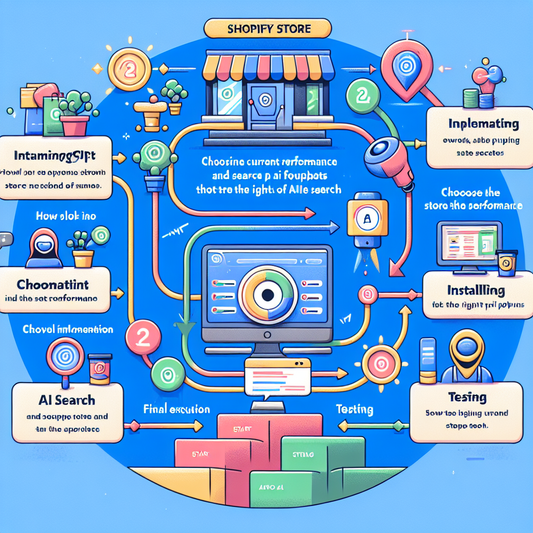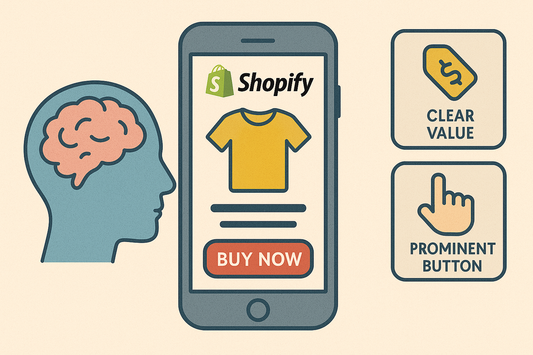
A Shopify store owner reviewing AI-driven search insights on a laptop while testing product copy improvements inspired by ChatGPT.
Why Optimizing Your Shopify Store for ChatGPT and AI Search Is Now Essential
- Understanding How AI Search and ChatGPT-Like Models Discover Ecommerce Content AI-powered search and conversational assistants like ChatGPT are not traditional search engines that simply match keywords. They ingest diverse signals, including structured data, product attributes, content context, user intent inferred from conversational prompts, and embeddings extracted from text. For Shopify store owners that means product pages, collection descriptions, FAQs, blog posts, and even customer reviews become raw material that an AI model can summarize, paraphrase, and surface as answers to user queries. Businesses that treat product pages as static catalog entries miss the opportunity to be present in the conversational path to purchase. Optimizing for this new layer of search starts with thinking in terms of meaning and intent rather than just single keywords. That shift impacts how you write metadata, how you structure product information, and how you signal the right knowledge to AI systems through schema, clean copy, and high-quality context. In practical terms, structured attributes such as color, size, material, care instructions, and SKU should be machine-readable and consistent across the catalog so embeddings capture those distinctions. Content that answers common customer questions, explained in natural language and placed near product details, increases the likelihood that an AI will use your store as a credible source when it constructs conversational responses. It's the difference between being a passive listing and becoming an authoritative source that an AI assistant recommends when a buyer asks, 'What's the best moisture barrier face cream for dry sensitive skin available from independent brands in the US that ships internationally.'
- Build Rich Product Signals with Structured Data and Schema Schema markup and structured data are no longer optional extras for SEO; they are one of the clearest signals you can send to AI systems that crawl or consume your content. Structured data clarifies product attributes, pricing, availability, brand information, ratings, and reviews in ways that are unambiguous for machines. Instead of relying solely on visible text that may be noisy, schema allows you to declare authoritative values. For Shopify merchants, adding structured data is achievable in multiple ways — through theme changes, apps, or by inserting JSON-LD snippets into sections that render on relevant pages. When you provide consistent schema across your catalog, it helps AI agents generate accurate product summaries and reduces ambiguity when answers are compiled from multiple data sources. Practical recommendations include ensuring each product page includes product schema with name, description, SKU, brand, price, currency, availability, images, aggregate rating, reviews, and gtin or mpn when available. Also include FAQ schema for common questions and answer pairs, how-to schema for instructional products, and review schema for user-generated content. Case study evidence shows that merchants who implemented comprehensive schema and expanded FAQ content experienced increased visibility in question-answer features on both search engines and conversational platforms, leading to higher referral traffic and improved conversion rates since the content better matched purchase intent and questions customers actually asked.
- Rewrite Product Copy for Conversational Relevance and Intent Matching Traditional ecommerce product copy tends to focus on key selling points and benefits, but not always on the explicit questions users ask in conversation. AI assistants often synthesize answers across multiple pages and prefer content that reads naturally and addresses practical buyer concerns. Successful optimization requires rethinking copywriting to include short conversational summaries, question-and-answer snippets, and scenario-based usage details. For every product, create a short, one-sentence summary that captures the unique value proposition in natural language, plus 3-5 common questions and straightforward answers that a buyer might ask in a chat. Use natural phrasing and avoid dense marketing jargon that could confuse an assistant trying to extract meaning. For example, instead of only saying 'Ultra-absorbent microfiber towel', add 'Ideal for travelers who need a lightweight, quick-drying towel that folds small and still soaks up water fast.' This type of contextual, use-case focused phrasing increases the likelihood an AI will surface your product as an answer to multi-part queries about travel gear. In practice, merchants that added short conversational summaries and explicit Q&A around product pages reported that their content started appearing in more 'featured snippet' style responses and voice assistant results, which often leads to higher click-through rates from users who were already in a purchase mindset.
- Leverage Site Architecture and Internal Linking to Signal Relevance Site structure has always mattered for SEO, and its importance grows in the AI era. A clear, logical architecture helps AI models and search crawlers understand relationships between products, collections, and content. For Shopify stores, this means thoughtfully designing collections, using descriptive collection titles and descriptions, and creating hubs of authority around product categories and buyer intents. Internal linking patterns should prioritize user journeys — connecting blog posts that answer product use questions to related product pages, and linking complementary product pages with short explanatory anchor text that reads naturally. For AI systems that rely on graph-like signals and site context to generate responses, a coherent information architecture makes your store more likely to be trusted as a source. Implement breadcrumb navigation where appropriate, maintain a shallow click depth for core pages, and ensure collection pages include useful, unique descriptions not just templated text. A practical tactic is to create 'intent landing pages' that aggregate products for specific buyer problems, such as 'gift ideas for new parents' or 'long flights essentials', each of which contains curated product lists, buyer tips, and a compact FAQ. These pages perform well both for conversational AI queries and for traditional search, because they frame product choices around real human problems rather than isolated attributes.
- Invest in High-Quality, Diverse Content Types That AI Prefers AI search doesn't only read text; it can incorporate signals from images, alt text, structured content like tables and bulleted lists, videos, and user-generated content. Diversifying the types of content on your Shopify store increases the chances that an AI will retrieve at least one high-quality signal from your site to answer a complex query. High-resolution product images with descriptive alt attributes, short product demo videos with captions and transcripts, user Q&A sections, and structured comparison tables all contribute valuable context. Also consider producing long-form content such as how-to guides, product roundups, and troubleshooting articles that truly solve customer problems. These content assets act as anchors for your brand's expertise and make it more likely that an AI assistant will consider your store an authoritative source when synthesizing answers. Example: a home fitness brand that added short video tutorials with transcripts and a series of problem-solution blog posts saw a measurable uptick in conversational traffic and a higher rate of 'assisted conversions' where users referenced content in chat before making a purchase. The core idea is to think multimodally and ensure every asset includes machine-readable metadata and human-focused clarity.
Practical, Step-by-Step Strategies to Optimize Your Shopify Store for AI and ChatGPT
Article Topics:

1. Audit and Prepare Your Catalog: Data Hygiene and Prioritization
Start with a rigorous catalog audit. An AI or ChatGPT-like system will give preference to clear, consistent, and complete data. This begins with eliminating duplicates, standardizing naming conventions, and ensuring every product has a clean title, readable short description, long description, and a list of attributes. Prioritize products and categories that generate the most revenue, have unique selling propositions, or answer common customer questions. For each prioritized product, perform these actions: 1) Standardize the title format to include the primary attribute and brand without stuffing keywords. 2) Ensure product descriptions include a one-line conversational summary, three to five bullet-point features, practical usage scenarios, and a short FAQ with two to three questions. 3) Add structured attributes in Shopify metafields for color, material, size, care instructions, warranty, lead time, and GTIN/MPN where applicable. 4) Populate image alt text with descriptive phrases that include use-case language instead of keyword lists. 5) Capture and display customer reviews and include curated review excerpts that highlight real use-cases. During the audit, log content gaps and identify pages missing schema, videos, or user-generated content. Use that log to create a prioritized roadmap where you update the top 10-20% of SKUs that drive 80% of your revenue first. Case evidence from stores pursuing this method shows that a focused catalog cleanup of their top-selling SKUs can lead to disproportionate improvements in AI-driven discovery and conversion because the most trafficked pages are also the ones most likely to be used as source material in a conversational answer.
2. Implement Schema, Structured Data, and Metafields Correctly
Implementing schema is a technical but high-leverage play. Start by mapping which schema types each page should include: product pages should carry product, offer, aggregateRating, review, and FAQ schema where relevant; collection pages can benefit from breadcrumb and collection-level descriptions with itemList schema when you're curating lists; blog posts should include article schema and author information. Explore Shopify metafields to store clean, structured attributes that you can render into JSON-LD. Maintain a clear naming convention for metafields so that attributes like 'material', 'care_instructions', 'size_chart', and 'warranty_period' are consistent across themes and apps. When generating JSON-LD for each product, include only accurate data and guard against exposing internal staging data or placeholders. Also implement schema for local business information if you have a physical location, including accurate opening hours and contact details to help with local conversational queries. Testing schema with structured data testing tools and validating JSON-LD ensures AI systems can parse your content. A real-world example: a fashion retailer that invested time into mapping and populating metafields for fabric composition, fit notes, and model sizes then rendered that as schema saw AI assistants and voice search systems returning their product pages more frequently in conversational comparisons where fit and fabric matter. The key is precise, accurate schema, and then continuous validation as you update your catalog.
3. Design Conversational Snippets, FAQs, and Prompts That Mirror Real Questions
AI performs best when it can match a human-style question to an explicit human-style answer on your site. Create conversational snippets that are short, factual, and focused on common buyer intents. Use a framework to gather real customer questions from chat transcripts, customer service logs, social media comments, and search query data. For each product or theme, craft two to five crisp Q&A pairs that live on the product page and are also encoded in FAQ schema. These should address shipping, sizing, returns, materials, warranty, compatibility, and lifestyle fit. Additionally, create short conversational lead-ins at the top of product pages like 'Looking for something for sensitive skin? This works well if you prefer unscented options' which are directly useful to AI agents. Another tactic is to include 'If you're choosing between X and Y' comparison boxes written in plain language that summarize differences, trade-offs, and which customer profile best matches each product. For chat-driven discovery, also provide short 'prompts' that customers can copy into a chatbot, such as 'Which of your travel backpacks fits a 15-inch laptop and has TSA-friendly access?' In one case, a niche outdoor brand transformed their commonly asked customer service questions into FAQ schema and saw those product pages surface in conversational results for queries about 'waterproof vs water-resistant' a lot more often. The long-term benefit is reduced friction in the buyer journey because an AI assistant that references your store can answer common clarifying questions without routing the user to a competitor.
4. Optimize Multimedia and Multimodal Signals: Images, Video, and Alt Text
AI models increasingly benefit from multimodal content. For Shopify stores, this translates into optimizing images, videos, and supporting metadata so they contribute to your overall visibility in conversational contexts. For images, use high-resolution photography and include descriptive alt text that explains not just the object but its context and use-case, for example 'Short wool sweater modeled for chilly evening hikes with tapered cuffs' rather than 'wool sweater.' Use image filenames that are descriptive and natural language oriented, and include structured captions where relevant. Video content should be short, focused, and come with accurate transcripts or captions that are publicly available on the page so machines can parse them. Tutorial videos, product demonstrations, and comparison clips are especially helpful. If you have 360-degree views or interactive size guides, ensure the underlying content is crawlable or accompanied by a text alternative explaining what the interactive shows. Finally, host or embed media in a way that allows your theme to expose metadata such as duration, quality, and purpose. A home goods studio that invested in short demonstration videos with transcripts and highlighted use-case captions saw its product pages recommended more often in AI-generated content that compared 'best beds for back pain that allow cooling', because the videos explicitly described user outcomes that are commonly asked about in conversational queries.
Key Takeaways and an Action Roadmap to Get Started

-
Shift from keyword-centric to intent-centric optimization
Traditional SEO tactics focused on matching exact keywords often fall short in the age of AI-driven conversation. Prioritize understanding buyer intents and craft content that answers complete questions. This means writing product descriptions and collection pages that start by addressing user problems, then list features and practical use cases. Convert your product information into short, conversational snippets and FAQ entries so AI assistants can extract the most relevant information quickly. The impact of this shift is measurable: when you align content with intent, you increase the chance your store becomes the referenced source in a user's query, improve the quality of traffic, and reduce time-to-purchase because users receive the precise answer they needed to convert.
-
Implement structured data and metafields comprehensively
Structured data is a lingua franca for machines. Use Shopify metafields to store product attributes consistently and render them into JSON-LD schema on every product and collection page. Ensure that schema fields are accurate and complete for price, availability, GTINs, ratings, and FAQ pairs. This reduces ambiguity and helps conversational systems trust your data when synthesizing answers. Maintaining well-formed schema also makes it easier to integrate with downstream systems such as feed managers, comparison services, and AI platforms that rely on clean inputs to build embeddings and knowledge graphs.
-
Produce multimodal, problem-focused content
AI performs best when it can match a human-style question to an explicit human-style answer on your site. Create conversational snippets that are short, factual, and focused on common buyer intents. Use a framework to gather real customer questions from chat transcripts, customer service logs, social media comments, and search query data. For each product or theme, craft two to five crisp Q&A pairs that live on the product page and are also encoded in FAQ schema. These should address shipping, sizing, returns, materials, warranty, compatibility, and lifestyle fit. Additionally, create short conversational lead-ins at the top of product pages like 'Looking for something for sensitive skin? This works well if you prefer unscented options' which are directly useful to AI agents. Another tactic is to include 'If you're choosing between X and Y' comparison boxes written in plain language that summarize differences, trade-offs, and which customer profile best matches each product. For chat-driven discovery, also provide short 'prompts' that customers can copy into a chatbot, such as 'Which of your travel backpacks fits a 15-inch laptop and has TSA-friendly access?' In one case, a niche outdoor brand transformed their commonly asked customer service questions into FAQ schema and saw those product pages surface in conversational results for queries about 'waterproof vs water-resistant' a lot more often. The long-term benefit is reduced friction in the buyer journey because an AI assistant that references your store can answer common clarifying questions without routing the user to a competitor.
-
Measure conversational performance and iterate
AI models increasingly benefit from multimodal content. For Shopify stores, this translates into optimizing images, videos, and supporting metadata so they contribute to your overall visibility in conversational contexts. For images, use high-resolution photography and include descriptive alt text that explains not just the object but its context and use-case, for example 'Short wool sweater modeled for chilly evening hikes with tapered cuffs' rather than 'wool sweater.' Use image filenames that are descriptive and natural language oriented, and include structured captions where relevant. Video content should be short, focused, and come with accurate transcripts or captions that are publicly available on the page so machines can parse them. Tutorial videos, product demonstrations, and comparison clips are especially helpful. If you have 360-degree views or interactive size guides, ensure the underlying content is crawlable or accompanied by a text alternative explaining what the interactive shows. Finally, host or embed media in a way that allows your theme to expose metadata such as duration, quality, and purpose. A home goods studio that invested in short demonstration videos with transcripts and highlighted use-case captions saw its product pages recommended more often in AI-generated content that compared 'best beds for back pain that allow cooling', because the videos explicitly described user outcomes that are commonly asked about in conversational queries.
-
Prioritize privacy, trust, and transparent product information
As AI assistants increasingly rely on public content to generate answers, transparent and trustworthy product information becomes a competitive advantage. Avoid misleading or exaggerated claims, clearly state return policies, shipping times, warranty terms, and provide accurate stock and pricing data. Respect customer privacy by anonymizing user-generated content when necessary and ensuring your data collection and consent practices are clear. Trust signals like verified reviews, consistent pricing, and transparent policies reduce friction in conversational contexts where a user might ask whether they can return a product or expect delivery within a certain timeframe. Ethical, trustworthy content not only protects your brand but increases the likelihood that AI systems will surface your content as a reliable source.
Boost your conversion rates with our powerful Shopify Public App by offering tiered pricing and volume discounts.





